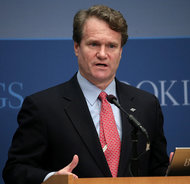Wall Street fell sharply Wednesday, with industrial and financial sectors leading the market down more than 1 percent.
The three major benchmarks — the Standard Poor’s 500-stock index, the Dow Jones industrial average and the Nasdaq composite — were all down about 1.1 percent in afternoon trading. The Dow was just above the 15,000-point level.
A private sector jobs report released earlier showed companies picked up the pace of hiring in May, though job growth remained sluggish. The report came ahead of the crucial nonfarm payrolls report on Friday.
“The market is overlooking this disappointing number, and putting greater emphasis on the nonfarm payrolls for better clues on what the Fed is going to do,” said Andrew Wilkinson, chief economic strategist at Miller Tabak Company.
A separate report showed a gauge of United States labor-related costs fell in the first quarter by the largest amount in four years, although the reading appeared distorted by a shift in employee compensation during the prior period to avoid a tax hike.
Trading has been volatile over the last few weeks amid a slew of economic reports and comments from Fed officials that have hinted on when the Fed may start reducing its stimulus efforts, which have powered this year’s stock market rally.
The market is expected to continue to be volatile this week, with intraday swings of more than 1 percent in either direction during a single trading session.
The American International Group said on Tuesday that a proposed $8.5 billion settlement between Bank of America and investors of Countrywide Financial mortgage-backed securities was not big enough. A.I.G. shares gained 1.2 percent.
The Treasury Department said it would begin another round of sales of the General Motors stock it acquired during the government’s bailout of the auto sector. The stock was down 2.1 percent.
European shares fell on concerns that the United States might begin to taper economic stimulus measures, with the FTSE 100 index ending 2.1 percent lower.
Comments late on Tuesday from two senior Federal Reserve officials highlighted divisions over the future of the central bank’s stimulus program.
Richard Fisher, president of the Federal Reserve Bank of Dallas, and Esther George, president of the Federal Reserve Bank of Kansas City — both long-term critics of the bond-buying program — reiterated their concerns over the risks of waiting too long to cut it back.
“The markets are hanging on every word of the central bankers in Europe and the U.S.,” said Richard Griffiths, a Berkeley Futures associate director.
Japan’s Nikkei share average sagged to a two-month low on Wednesday, as Prime Minister Shinzo Abe pledged to bolster incomes and attract foreign businesses, but did not mention a proposal to encourage Japan’s public funds to seek higher returns by investing more in riskier assets like equities.
“Investor expectations were for more specific growth policies and the disappointment has only exacerbated a trend for a correction in Japan’s stock market,” said Lee Hardman, currency analyst for Bank of Tokyo-Mitsubishi UFJ.
Since the Nikkei index rose to a five-and-a-half-year high on May 23, up more than 50 percent this year, doubts about the effectiveness of Mr. Abe’s economic reforms and the Bank of Japan’s stimulus efforts have led to a steady erosion of the gains.

Article source: http://www.nytimes.com/2013/06/06/business/daily-stock-market-activity.html?partner=rss&emc=rss

